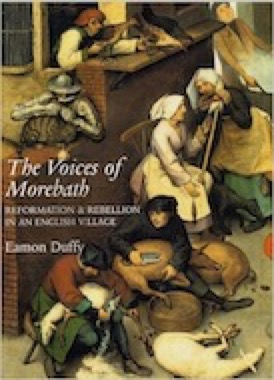Academic Review - The Voices of Morebath
February/23/2017 11:08 PM Filed: Academic Reviews

Author: Eamon Duffy
(Yale University Press)
The Voices of Morebath: Reformation and Rebellion in an English Village
Eamon Duffy interprets the words of Sir Christopher Trychay, a Catholic priest who holds a tiny English village together during the Reformation. Published in 2001 by Yale University Press, this detailed account of events in Morebath provides primary documentation along with secondary analysis. Although limited to one small part of England, comprehension of the religious upheaval that took place on a larger scale is possible by examining the lives of a few.
What makes Trychay unusual is his ability to work with Catholics and Protestants. He started as a Catholic, abided by changes implemented during the Reformation at the time of King Henry VIII, converted back to Catholicism during the reign of Queen Mary, and returned to Protestantism when Queen Elizabeth took the throne. He strove to prevent bloodshed and unnecessary heartache.
This priest kept extensive financial records. Every transaction, everything added or removed from the church, he wrote down. Trychay kept track of births, baptisms, marriages, and deaths as well, but his focus remains a monetary one.
When Catholicism was at its peak, religious art thrived. Burglaries were common, and Trychay’s church was no exception. Tributes paid for by members of his parish adorned the interior. As insignificant as Morebath seems in comparison to a large city, its problems were similar—less to steal and fight over, yet enough to cause trouble for residents. Patrons would donate an item to the church only to see it removed.
Suppression of idolatry, known as iconoclasm, resulted in the confiscation of statues, sculptures, paintings, and trinkets with symbolic meaning that Protestant authorities found questionable. Catholics of the 1500s were superstitious as well as artistic. Since church and government were intertwined, deifying a person or an object could be considered a crime. Refusal to comply with a mandate might result in death.
Trychay cooperated with the dictates of the monarch in charge, but people in his parish recoiled as Reformation orders were carried out. On a philosophical level there would never be agreement. On a legal level there could be cooperation as long as an educated minority made the decisions.
“We are forever shut out from all but the surface of Morebath’s religion,” Duffy writes. “Late medieval Christianity moved between distinct but complimentary poles—public and private, the religion of the liturgy and the religion of the heart.”
Catholics discouraged the education of anyone but the controlling elite because authorities feared the influence of outsiders would change the status quo. The Reformation was an underground movement, and no one knew for certain where a person’s sympathies lay. Protestants encouraged education and transformation. Sudden involvement of so-called underdogs threatened the establishment.
Duffy emphasizes the significance of worshipping in English rather than Latin. The liturgy was now understandable to the average villager. The church remained the focus of their existence, the glue that held their community together. Religious turmoil meant personal turmoil, even to the point of psychological disturbance and violence. Resistance to the Reformation may have been aversion to change as much as rebellion against Protestantism.
Humiliating and punishing women to control objectionable behavior Duffy describes as “a coarsening of social fibre.” Protestants allowed a woman more power and autonomy, while Catholics placed her on a maternal pedestal, a symbol of nurturing, subdued perfection. Abusive men likely had difficulty adjusting to the elevation of a woman’s status beyond her traditional roles as wife and caregiver.
Duffy presents his research well, sharing his knowledge without an overwhelming excess of detail. His admiration for Sir Christopher Trychay is apparent. While remaining sympathetic to the persecution of Catholics, he criticizes counter-Reformation rebellion. Protestants and Catholics have the right to exist side by side. His text is a worthwhile study of Renaissance theological history.